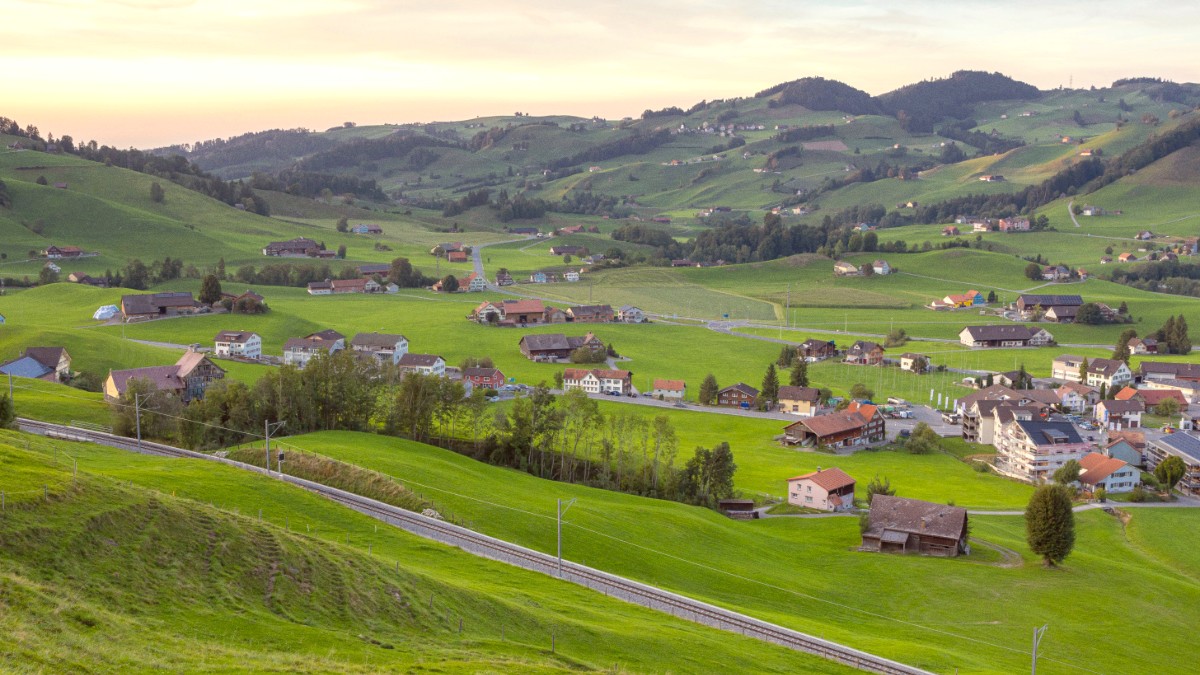
Switzerland
Appenzell Ausserrhoden offers a gentler, more undulating landscape. Its rolling hills and verdant valleys are marked by scattered farmhouses and small, picturesque villages. This part of the region is equally scenic but presents a different kind of beauty, with pastures giving way to forests and more accessible walking paths. The main town of Appenzell, located in Innerrhoden, is a hub for the entire region. It makes a convenient base for exploring both the challenging alpine terrain of Innerrhoden and the softer, pastoral scenes of Ausserrhoden. The Sitter River, a tributary of the Thur, winds its way through parts of the region, adding to the natural charm and local water sources.
Geographical distinctions between Appenzell Innerrhoden and Appenzell Ausserrhoden shape trip options. Innerrhoden features rugged hiking, while Ausserrhoden invites gentler walks and cycling.
The canton of St. Gallen borders Appenzell, a gateway to the region. This proximity means St. Gallen’s urban center and transport connections are easily accessible. Travelers often arrive via St. Gallen, using its railway network to reach Appenzell's heart.
The Appenzell region possesses a history as rich and layered as its landscape. Originally, the area fell under the dominion of the powerful Abbey of St. Gallen, a Benedictine monastery with considerable influence. This ecclesiastical control shaped early regional development. Local inhabitants increasingly sought autonomy. This desire for self-determination eventually led to a series of conflicts. By the 15th century, the people of Appenzell successfully gained independence from the Abbey, a testament to their enduring spirit.
Following its independence, Appenzell joined the Swiss Confederation in 1513. This integration brought protection and stability. However, unity faced internal challenges. The Reformation in the 16th century brought significant religious divisions. Appenzell found itself split along confessional lines. Some areas embraced Protestantism, others remained Catholic. This religious schism led to a formal division of the canton in 1597. Appenzell Innerrhoden stayed Catholic, preserving its beliefs. Appenzell Ausserrhoden adopted Protestantism, forging a distinct cultural identity.
Appenzell Innerrhoden and Appenzell Ausserrhoden are distinct entities, administratively and historically. Researching specific events or rules for each half-canton makes for a thorough trip plan.
A compelling symbol of Appenzell Innerrhoden's direct democratic heritage is the Landsgemeinde. This open-air assembly, held annually on the last Sunday of April, gathers citizens to vote on cantonal matters.
Citizens raise their hands to cast votes, highlighting an ancient form of direct democracy. Men traditionally carry a sword, while women present a voting card. This practice connects citizens to a long history of self-governance.
The historical narrative of Appenzell demonstrates resilience, a deep connection to tradition, and steadfast commitment to local identity. These historical threads weave through the landscape and customs.
The successful gaining of independence from the Abbey shows an enduring spirit and resolve.
A notably compelling symbol of Appenzell Innerrhoden's direct democratic heritage is the Landsgemeinde. This open-air assembly, held annually on the last Sunday of April, gathers citizens in the main square of Appenzell town to vote on cantonal matters. Citizens raise their hands to cast their vote, a practice highlighting an ancient form of direct democracy rarely seen elsewhere in the modern world.
Men traditionally carry a sword as a symbol of their right to vote and serve in the army, while women present a voting card. This practice, though ceremonial in some aspects, connects present-day citizens directly to the region's long history of self-governance and democratic participation.
The historical narrative of Appenzell shows resilience, a deep connection to tradition, and a steadfast commitment to local identity. These historical threads weave through the landscape, the architecture, and the customs you will encounter.
Appenzell offers a truly authentic Swiss experience, combining natural beauty with a preserved cultural identity. It beckons a slower pace, fostering connection with nature and centuries-old traditions.
Appenzell delivers a distinct Swiss experience, setting it apart from often-busy tourist hubs. The region presents a blend of natural beauty, deep-rooted traditions, and a welcoming atmosphere. This snapshot provides a concise overview, preparing you for what to expect and what makes Appenzell a compelling destination.
The Appenzell region divides into two half-cantons: Appenzell Innerrhoden (AI) and Appenzell Ausserrhoden (AR). This historical split, based on religious differences centuries ago, gives each half-canton a slightly different character. Appenzell Innerrhoden is more mountainous and traditionally Catholic, known for its iconic Landsgemeinde. Appenzell Ausserrhoden features rolling hills, a Protestant heritage, and a more dispersed settlement pattern. Both offer remarkable beauty and a shared Appenzeller identity. Visitors move freely between them, though understanding the distinction can enrich appreciation of local traditions.
The Alpstein massif presents a dramatic backdrop, with peaks, deep valleys, and beautiful mountain lakes. Beyond the high peaks, Appenzell Ausserrhoden features picturesque rolling hills, dotted with traditional farmhouses.
Swiss German, specifically the Appenzeller dialect, is the main language. Standard German stands widely understood. English often appears in tourist areas. The region is known for unique direct democracy and charming painted houses.
Agriculture, dairy farming specifically, shapes the region's culture and economy. Appenzeller cheese is a renowned product. The Appenzeller Show Dairy in Stein offers insight into its production.
Appenzell's character grows from several defining aspects:
The canton of St. Gallen borders Appenzell, a gateway to the region. This proximity means St. Gallen’s urban center and transport connections are easily accessible. Travelers often arrive via St. Gallen, using its railway network to reach Appenzell's heart.